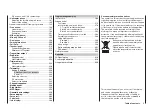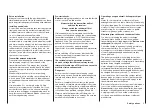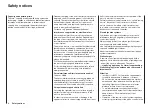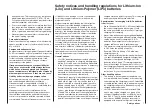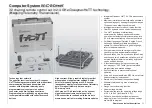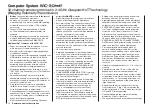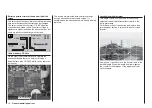
5
Safety notices
Pre-start checks
Before
switching the receiver on, be sure the throttle
control is at its Stop/Idle position.
Always switch the transmitter on fi rst
and then the receiver.
Always switch the receiver off fi rst
and then the transmitter.
If this sequence is not maintained, such that the
receiver is still switched on when the corresponding
transmitter is switched to "OFF", then the receiver
may respond to other transmitters or general radio
frequency noise. This can cause the model to
execute uncontrolled operations that may cause
personal injuries and/or property damage.
In particular, for models
equipped with a mechanical
gyro
:
before switching off the receiver, disconnect the
model's power supply to prevent the motor from
revving up unintentionally.
The residual spin of a gyro often produces
so much voltage that the receiver may falsely
interpret a throttle signal! This will then cause the
motor to start up unexpectedly.
Range test
Perform checks for proper operation and range
before every
session
. Secure the model adequately
in place and ensure that no one is in front of the
model.
Perform a complete functional test on the ground
and execute a complete simulated fl ight to exclude
the possibility of system faults or problems with the
model's programming. When doing this, be sure to
follow the notices provided on pages 80 and 88.
Never operate the transmitter in Model mode, i.e.
for fl ying or driving, without an antenna. Be sure the
antenna is fi rmly seated in its socket.
Operating a winged aircraft, helicopter, ship or
car
Never fl y over spectators or other pilots. Never
endanger humans or animals. Never fl y in the vicinity
of high-voltage wires. Do not operate the model in the
vicinity of sluice locks or where real boats or ships
are operating. Do not operate a model on public
streets or highways, paths or plazas, etc.
Monitoring transmitter and receiver batteries
You must stop running the model to recharge
the transmitter's battery no later than when low
transmitter battery voltage triggers the "
Batt must be
recharged!!
" display and acoustic signal.
Check the charge in batteries routinely, particularly
the receiver's battery. Do not wait until the
movements of controlled mechanisms are noticeably
slower. Replace expended batteries before they
cause problems.
The battery manufacturer's charging instructions
are always to be followed, this includes mandatory
adherence to the length of charging time. Never leave
batteries being charged unattended.
Never attempt to charge primary batteries (non-
rechargeable batteries) because they can explode.
All secondary batteries (rechargeable batteries) must
be charged before every session. To avoid short
circuit conditions, fi rst connect the charger cable's
banana plugs, polarity correct, into the charger and
thereafter connect the charger cable's plugs to the
transmitter and receiver batteries.
Disconnect all power sources from the model when it
is not to be used for an extended period of time.
Never
attempt to use defective batteries, damaged
batteries or mixed-type battery combinations as
a single group. Do not use mixed combinations
of old and new batteries or batteries of different
manufacture.
Servo installation
Always mount servos with the provided rubber
vibration-damper parts. Only in this manner can these
parts be protected against excessively hard vibrations.
Installing control rods
Control rods must be installed such that they operate
freely and smoothly. It is particularly important that
all rudder levers are able to move to their full limits,
i.e. not otherwise mechanically blocked.
In order to be able to stop a running motor at any
time, control rods must be adjusted such that the
carburetor tap is completely closed when the joystick
and trim wheel are brought into their end idle position.
Pay attention that no metal parts, e.g. as a result of
rudder actuation, vibration, rotating parts, etc., rub
against one another. Metal-to-metal contact causes
electrical "noise" which can interfere with the correct
operation of the receiver.
Transmitter antenna orientation
Transmission fi eld strength is minimal in an imaginary
line extending straight out from the end of the
transmitter's antenna. This means that "pointing"
the transmitter's antenna directly toward the model
will not produce good reception but rather degrade
reception.
When multiple remote controls are operating
simultaneously, pilots should position themselves in
a loose group. Pilots standing off to themselves not
only endanger their own models but those of others
as well.
However, when 2 or more pilots using 2.4 GHz
remote control systems are closer than 5 m to one
another this can lead to return channel overdrive
which, in turn, will trigger a range warning much too
early. Increase your distance between one another
until the range warning ceases.
Summary of Contents for 32032
Page 1: ...33020 mc 20HoTT 2 en Programming Manual o Pro Pro mc 20 mc 20...
Page 15: ...15 For your notes...
Page 21: ......
Page 27: ...27 For your notes...
Page 41: ...41 For your notes...
Page 53: ...53 For your notes...
Page 59: ...59 For your notes...
Page 63: ...63 For your notes...
Page 93: ...93 For your notes...
Page 97: ...97 For your notes...
Page 141: ...141 How is a ight phase programmed...
Page 145: ...145 For your notes...
Page 155: ...155 For your notes...
Page 175: ...175 For your notes...
Page 203: ...203 For your notes...
Page 219: ...219 For your notes...
Page 253: ...253 For your notes...
Page 283: ...283 For your notes...
Page 321: ...321 For your notes...
Page 322: ...322 For your notes...
Page 323: ...323 For your notes...



